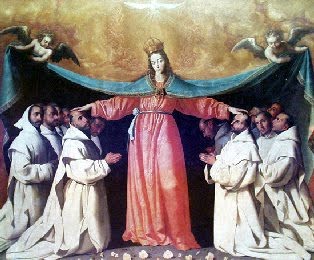 In the Prologue of the book titled, ‘Saint Bruno the Carthusian’ by André Ravier, S. J., is a description of how it all began for Saint Bruno and his companions; how it all began for the Carthusian Order. Here is that story.
In the Prologue of the book titled, ‘Saint Bruno the Carthusian’ by André Ravier, S. J., is a description of how it all began for Saint Bruno and his companions; how it all began for the Carthusian Order. Here is that story.On a June morning in 1084, about the time of the feast of Saint John the Baptist, a small, serious-looking group of poorly clothed travellers left the Bishop’s house in Grenoble, led by young Bishop Hugh. They headed north and took the road to Sappey. After passing the last houses of the town they entered the great forest, cleared the Palaquit Pass, and reached the Porte Pass at an altitude of 4,000 feet (1,219 metres). From the pass they descended to the village of Saint-Pierre-de-Chartreuse. But, shortly before they reached Saint-Pierre, they turned left into the Valley of Guiers-Mort. This very narrow valley grew narrower little by little until it was enclosed between two steep cliffs. Only the stream and the path found an exit to the west.
The ‘Gateway’ as this valley was called, was the sole entry from the south. A little beyond that, to the right, an oblong valley called the Wilderness of Chartreuse extended north-northeast about 3 miles (4.8 kilometres). Its lowest point was 2,350 feet (716 metres) above sea level, and the highest was 3,450 feet (1,052 metres). It was nearly enclosed on all sides by towering mountains which, at the Grand Som, reached an altitude of 6,000 feet (1829 metres). Except for the gateway of the valley, there was only one other way to enter. That was by La Ruchère Pass (4,250 feet or 1295 metres) toward the northwest, though the village of La Ruchère itself was accessible only by the dangerous route of the Frou, over two poor paths that were long, difficult, and very risky: one coming from Saint-Laurent of the Wilderness in the west (today called Saint-Laurent-du-Pont), the other from Saint-Pierre d’Entremont in the north. The latter went through the forest of Eparres, the home of wild animals, and up over the Bovinant Pass to an altitude of 5,000 feet (1524 metres). In this wilderness the travellers boldly summoned up their strength at the gateway of the valley and, since they were looking for the wildest place in this wild place, they climbed to the farthest point toward the north, where the wilderness terminated in a gorge that was enclosed by mountains so high that during most of the year the sun scarcely penetrated it. Amid the fallen rocks the strangely shaped trees still reached for the sky, that at least their tops might gain the open air, light, and warmth. Then the little band stopped. They had arrived. Bishop Hugh told his companions they should build their huts here and make their dream of a hermitage a reality. Taking leave of his companions, he went back down to Grenoble with his personal escort.
Seven men stayed in the Wilderness: Master Bruno, the former chancellor and canon of the Church of Rheims; Master Landuino from Lucca in Tuscany, a renowned theologian; Stephen of Bourg and Stephen of Dié, both canons of Saint-Ruf; Hugh, ‘whom they called the chaplain because he was the only one of them who functioned as a priest’ (Guigo, Vita S. Hugonis), and two ‘laymen’, Andrew and Guérin, who were lay brothers. These seven had decided to lead an eremitical life in common, and for some time they had been looking for a suitable place to carry out their project. Prompted by the Spirit and knowing surely how well how forests in the Dauphiné were suitable for solitude, Bruno came to Hugh, bishop of Grenoble, to ask for shelter and advice. And Hugh, inspired by a wonderful dream, chose the Wilderness of Chartreuse for Bruno and his companions.
Human wisdom would say the selection was foolish. The harsh climate with heavy snowfalls; the poor soil that required so much labour to provide even meagre nourishment for its inhabitants; the ruggedness of the terrain that made cultivation difficult in the forest; the inaccessibility of the place during a considerable part of the year, so that there was no hope of obtaining help quickly should there be an emergency or fire or illness. Everything was against establishing any sort of permanent dwelling for human beings in the Wilderness of Chartreuse, and especially in this northern end of it. Several times events demonstrated that these fears were well founded. On Saturday, 30 January 1132, an enormous avalanche fell upon all the cells except one and killed six hermits and one novice. They were compelled to go back a mile and a half (2.4 kilometres) toward the south from the end of the Wilderness, where La Grande Chartreuse is located now.
Bruno was more than fifty years old. Several of his companions, notably Landuino, were no longer young. What secret desire impelled them to brave this solitude, whose severity Guigo (the fifth prior of Chartreuse), in his ‘Customs’ (Consuetudines) alludes to twice? What discovery, what pearl of great price could make them live ‘for a long time amid so much snow and such dreadful cold’? (Consuetudines XXVIII).
The mystery of vocation, by which God calls certain people to a purely contemplative life and all-embracing love; the mystery of hidden lives of self-effacement (as it is commonly regarded) with Christ Who effaced Himself; the mystery of the prayer of Christ in the wilderness during the nights of His public life and at Gethsemane, the prayer of Christ that continues in certain privileged souls at every period in the history of the Church; the mystery of being solitary while remaining present to the world, of silence and the light of the Gospel, simplicity, and the glory of God.











